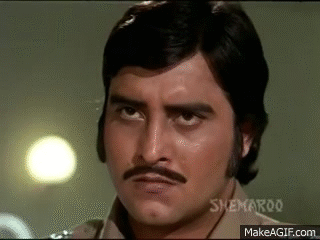(22-year-old Akriti Paracer saw ‘Amar Akbar Anthony’ for the first time recently and reviewed it.)
What was advertised as “Superhit Comedy” on YouTube started off as Meena Kumari’s fantasy and left me confused if Amar Akbar Anthony was indeed going to be funny for the next three hours.
In the next 15 minutes after the start, Pran shoots his ex-employer, steals his car without ever grabbing the keys, his wife Nirupa Roy attempts suicide but ends up going blind instead, Pran’s children get separated, and he steals a box full of gold and reverses his fortunes.
The film then spans 22 years and Nirupa Roy’s tuberculosis (yes, that too happens) is forgotten, much like several plot points. Amar Akbar Anthony could very well have been the first leave-your-brain-at-home film.
The basic premise of the film is that all three sons – Vinod Khanna, Amitabh Bachchan and Rishi Kapoor – grow up as followers of three different faiths, who then manage to reunite their family. The movie was clearly way ahead of its time, as were it to be made now, a definite ‘ghar wapsi’ would be demanded for Akbar and Anthony.
While Vinod Khanna didn’t have to do anything to show his Hindu-ness, Rishi Kapoor sang qawaalis and Amitabh Bachchan wore a cross around his neck and used words like “hoyenga” to show his Christian-ness.
Ah Bollywood, what would we do without your stereotypical portrayals?
That very same “Christian” accent is also used by the affluent and foreigners in Bollywood films, showing their clear other-ness from middle-class Indians.
So naturally, after Pran reversed his fortunes with a literal pot of gold, he also got that accent which made him sound like Captain Andrews from Lagaan. He then kidnaps his ex-boss’ daughter Parveen Babi and raises her like his own daughter, because it’s easier to kidnap one child than to find three lost ones.
He also clearly never went to his house where his wife Nirupa Roy had been living for the last 22 years since he started living in a mansion, blissfully unaware of the whereabouts of his wife and children, yet still grieving their loss.
All three brothers meet Nirupa Roy during the course of the film, call her maa endearingly while not knowing she is in fact their biological mother. It’s this sort of confusion which would have made this film a hit back in its day, when moviegoers were simpletons looking for such serendipity and not everyone was a film-critic. Ahem.
All three of them donate blood to her, to save her life, in a scene which looks like a bartender decided to play their doctor.
Amitabh Bachchan was the clear hero of the film, given his multiple elaborate fight sequences to establish himself as the alpha male.
The only fight he lost was to his older brother, Vinod Khanna, because sanskaar and how can a younger brother defeat the older one?
Rishi Kapoor was a doe-eyed pacifist, in love with Neetu Kapoor, whose father only agreed to let them get married after he saved them both from a burning building.
Vinod Khanna and Shabana Azmi were in love and incognito for a better part of the film, as there’s only so many storylines that can be squeezed into three hours.
Amidst all this, an important development happened which no one noticed. Parveen Babi inspired Baywatch.
The film goes from one action sequence to another heavily dramatic one while being peppered with some comedy and the romances of all three couples.
Nirupa Roy gets her eyesight back after listening to a bhajan at a Sai Baba mandir in possibly one of the most dramatic ways. The following visual is the exact moment she can see again.
Then, as the movie comes to a close, the family unites and defeats the bad guys with the power of three – Amar, Akbar, Anthony – and then they drive off into a beautiful Bombay sunset. And a literal ghar wapsi is done.
Final Verdict
Bachchan got into fights, Kapoor overacted and Khanna looked like a sight for sore eyes. The film’s exaggerated machismo, hamming and costumes that looked like they were designed by the neighbourhood darzi are quintessential to 70s Bollywood. However, it did leave me with some burning questions!
(This article is from The Quint’s archives and was first published on 22 June 2017. It is now being republished to mark Manmohan Desai’s birth anniversary.)
(At The Quint, we question everything. Play an active role in shaping our journalism by becoming a member today.)
.jpg?rect=0%2C0%2C1920%2C1080&auto=format%2Ccompress&fmt=webp&width=720)


